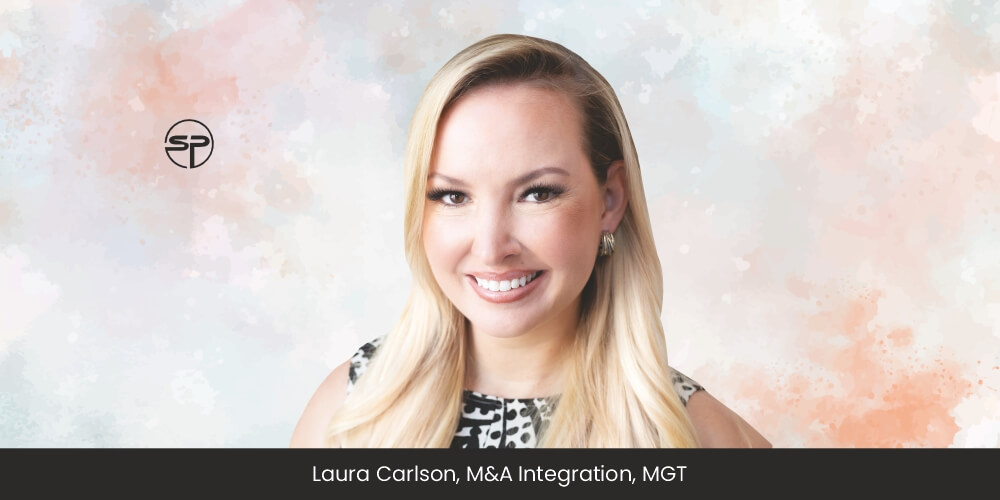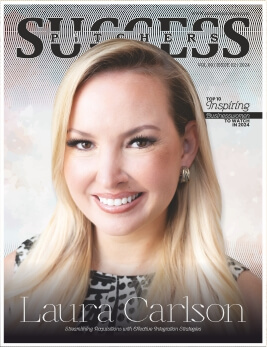Laura Carlson: Streamlining Acquisitions with Effective Integration Strategies
Top 10 Inspiring Businesswomen to Watch in 2024

With over 15 years of experience in process improvement and M&A integration, Laura Carlson has played a pivotal role in ensuring the seamless integration of acquired firms. At MGT, she is responsible for collaborating with stakeholders to successfully onboard and integrate new acquisitions, managing operational transitions, and monitoring the effectiveness of acquisition integrations and strategic initiatives.
Laura has been instrumental in the development of integration playbooks for both publicly-traded and private equity companies. These playbooks provide comprehensive guides for integration, including summaries, employee onboarding, and strategic planning. Her focus is on continuously improving the integration process to ensure smooth transitions for both acquired companies and their teams.
Early Career and Process Improvement Expertise
After earning a Bachelor of Science in Business Management from the University of Alabama at Birmingham, Laura began her career at Motion Industries as a trainee. She quickly transitioned into their Process Improvement group, where she spent 9 years collaborating with stakeholders from various departments, including IT, Accounting, HR, Operations, Customers, and Vendors. During this time, Laura worked on over 50 projects, generating $1.5 million in annual synergies.
At Motion Industries, Laura took on a new role developing an integration plan for their acquisitions. Her efforts in creating, streamlining, enhancing, and formalizing integration programs became a model for success. The integration program she developed for Motion Industries was later adopted as a roadmap for all Genuine Parts Company (GPC) subsidiaries.
Her expertise in building and refining these programs has made her a valuable asset at MGT, where she continues to ensure that each acquisition aligns with strategic goals and delivers long-term success.
Laura’s ability to bridge multiple departments and ensure that acquisitions are efficiently and effectively integrated has been central to her leadership at MGT. Her focus on improving processes and delivering seamless transitions has driven operational success and contributed to the overall growth of the companies she’s worked with.
Five Essential Lessons from Her Career
Laura has learned five key lessons in her career working in acquisitions, each contributing to smoother integrations and successful transitions. Here’s a breakdown of her insights:
- Single Point of Contact (PoC): Having one designated PoC is essential for streamlined communication. This person handles all communications, such as scheduling meetings, visits, and data requests, to ensure clarity and consistency throughout the process.
- Every Acquisition is Unique: While a structured integration process is necessary, Laura notes that no two acquisitions are identical. Flexibility is crucial, and the process should allow for adjustments as needed. Continuous process improvement across all stages, from due diligence to post-close, is also key.
- Communication is Crucial: Maintaining a regular meeting cadence is important after the Letter of Intent (LOI). As the process progresses, meetings will happen less frequently, but consistent monitoring of results and data sharing remains essential. A unified platform, like Deal Room, is beneficial for tracking progress and sharing updates among all stakeholders, helping ensure a seamless integration. After the integration phase, an Executive Sponsor should continue to support the acquisition in strategic growth planning.
- Onsite Visits Build Relationships: Face-to-face interaction, particularly for key team members like the PoC, Executive Sponsor, and onboarding teams, is invaluable. These visits help solidify the acquisition’s sense of inclusion within the new company and foster trust and alignment with the organization’s strategic goals.
- Company Swag Matters: A seemingly small gesture, like giving company-branded items on day one, can significantly impact how welcome and valued the acquisition feels. This simple act goes a long way in fostering team unity.
Laura also highlights the biggest challenge she has faced, which comes from the acquiring company itself. Different departments often want to impose their processes on the acquisition too quickly, leading to overwhelm. The Integration Management Office (IMO) can alleviate this by controlling communication, scheduling, and creating a phased integration plan. This ensures that teams know what steps to take and when, without overwhelming the acquisition team.
Streamlining Acquisition Integration with Structured Guidance
Laura highlights the importance of using standardized playbooks in conjunction with a well-established meeting cadence to ensure a smooth integration process and manage expectations effectively. She recommends creating four distinct playbooks tailored to different audiences and stages of the acquisition. The first is the Integration Summary Overview, aimed at the target company’s leadership during the Indication of Interest (IOI) stage. This playbook offers a high-level summary of the integration process, giving leadership an understanding of what to expect without delving into overwhelming details too early.
The second playbook is the Integration Detailed Overview, which is intended for internal integration team contacts, target company leadership during the Letter of Intent (LOI) stage, and acquisition employees once the acquisition is formally announced. This document outlines the integration timeline and provides a phased approach, ensuring that different departments—such as HR, IT Security, Insurance, and Accounting—begin the process first. Other departments, like Operations, IT Infrastructure, and Finance, can proceed in tandem, depending on who is involved. This phased strategy helps avoid overwhelming the acquisition and ensures that all communication is channeled through a single point of contact.
The Onboarding Playbook, designed for all employees, including those from the acquisition and any new hires, serves as a detailed guide to help them navigate the onboarding process. It provides clear instructions on what needs to be done and by when, ensuring that new employees transition smoothly into their roles within the new organization.
Finally, the Strategic Growth Planning Playbook is created for the Executive Sponsor and Acquisition Leadership Team. This playbook helps establish a roadmap for customized growth, leveraging the combined strengths of both companies, including services, territories, and customer bases, while also identifying opportunities for organic growth. By utilizing these standardized playbooks, Laura highlights the importance of structure, transparency, and communication in creating a successful and seamless integration.
Mastering Financial Transitions
Laura emphasizes that acquisition integration often centers around accounting and financial transitions. Her background in these areas, along with expertise in data analytics, plays a crucial role in ensuring smooth financial integration. Key tasks include identifying anomalies in the monthly financial statements and overseeing the transition of Accounts Receivable (AR), Accounts Payable (AP), and Collections processes. Additionally, Laura is involved in establishing budgets and financial goals for the newly acquired entity, creating payment schedules related to earnouts and escrow, and determining integration synergies.
Laura also focuses on defining key performance indicators (KPIs) to track the financial and operational progress of the acquisition. By closely monitoring these metrics, she ensures that the acquisition is aligned with both financial targets and strategic objectives. She then reports on the status of these goals to the Executive Team, keeping them informed of any challenges or achievements in the integration process. This holistic approach, combining financial oversight with operational alignment, helps drive successful acquisition outcomes.
Transforming Integration with Expertise and Compassion
One of the most defining moments in Laura’s career was when she had the opportunity to speak at GPC’s headquarters in Smyrna, GA, addressing subsidiaries about the integration program she had created. It was a special milestone as it represented the culmination of her years of experience in both integration and process improvement. During this moment, Laura provided suggestions on how to use the program as a roadmap to assist with their acquisitions, showcasing the breadth of her expertise.
Another deeply meaningful aspect of her career has been receiving gratitude from the leadership teams of the acquisitions she has worked with, who have often thanked her for making a highly complex process seamless and minimizing disruption to their business. Laura attributes her success to her natural talents in helping others, problem-solving, analytics, and organization—qualities that she has turned into a fulfilling career. This sense of purpose makes her passionate about her work, and she feels a genuine sense of happiness on any given Monday, not just in anticipation of the weekend.
Guiding the Journey to Self-Actualization and Empowerment
Laura’s leadership style can be described as highly trust-based and results-oriented. She fully trusts the people she works with, confident that they will tackle any task effectively. Her approach is hands-off and focused on delegation, while remaining available to assist and monitor progress to stay informed. She believes in empowering her team to take ownership of their work without being micromanaged, fostering both autonomy and accountability.
Laura underlines that leadership in any role requires a willingness to “get your hands dirty” when necessary, without losing sight of your own responsibilities. She leads by example, instilling trust in her team and being ready to offer support when needed. Her philosophy centers on maintaining a balance between guidance and trust, ensuring tasks are completed while also promoting a collaborative and self-sufficient environment.










